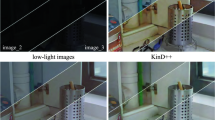Abstract
Multi-spectral imaging (MSI) produces a sequence of spectral images to capture the inner structure of different species, which was recently introduced into ocular disease diagnosis. However, the quality of MSI images can be significantly degraded by motion blur caused by the inevitable saccades and exposure time required for maintaining a sufficiently high signal-to-noise ratio. This degradation may confuse an ophthalmologist, reduce the examination quality, or defeat various image analysis algorithms. We propose an early work specially on deblurring sequential MSI images, which is distinguished from many of the current image deblurring techniques by resolving the blur kernel simultaneously for all the images in an MSI sequence. It is accomplished by incorporating several a priori constraints including the sharpness of the latent clear image, the spatial and temporal smoothness of the blur kernel and the similarity between temporally-neighboring images in MSI sequence. Specifically, we model the similarity between MSI images with mutual information considering the different wavelengths used for capturing different images in MSI sequence. The optimization of the proposed approach is based on a multi-scale framework and stepwise optimization strategy. Experimental results from 22 MSI sequences validate that our approach outperforms several state-of-the-art techniques in natural image deblurring.






Similar content being viewed by others
References
Dugel PU, Zimmer CN, Shahidi AM (2016) A case study of choroideremia carrier-use of multi-spectral imaging in highlighting clinical features. Retina Today. https://doi.org/10.1016/j.ajoc.2016.04.003
Li S, Huang L, Bai Y et al (2015) In vivo study of retinal transmission function in different sections of the choroidal structure using multispectral imaging. Invest Ophthalmol Vis Sci 56(6):3731. https://doi.org/10.1167/iovs.14-15783
Bhavsar KV, Mukkamala L, Freund KB (2015) Multimodal imaging in a severe case of hydroxychloroquine toxicity. Ophthalmic Surg Lasers 46(3):377–379. https://doi.org/10.3928/23258160-20150323-14
Calcagni A, Gibson JM, Styles I et al (2011) Multispectral retinal image analysis a novel non-invasive tool for retinal imaging. Eye 25(12):1562–1569. https://doi.org/10.1038/eye.2011.202
Switonski A, Blachowicz T, Zielinski M et al (2011) Ophthalmic diagnosis based on multispectral imaging. Przegld Elektrotechniczny
Everdell N, Styles IB, Calcagni A et al (2010) Multispectral imaging of the ocular fundus using light emitting diode illumination. Rev Sci Instrum 81(9):93706. https://doi.org/10.1063/1.3478001
Clancy NT, Stoyanov D, James DR et al (2012) Multispectral image alignment using a three channel endoscope in vivo during minimally invasive surgery. Biomed Opt Express 3(10):2567–2578. https://doi.org/10.1364/BOE.3.002567
Campisi P, Egiazarian K (2007) Blind image deconvolution: theory and applications. CRC Press, Boca Raton. https://doi.org/10.1201/9781420007299
Zhuang X, Arridge S, Hawkes DJ et al (2011) A nonrigid registration framework using spatially encoded mutual information and free-form deformations. IEEE Trans Med Imaging 30(10):1819–1828. https://doi.org/10.1109/TMI.2011.2150240
Relan D, Ballerini L, Trucco E et al (2016) Retinal vessel classification based on maximization of squared-loss mutual information. Springer, Berlin
Zheng Y, Wang Y, Jiao W et al (2017) Joint alignment of multispectral images via semidefinite programming. Biomed Opt Express 8(2):890–901. https://doi.org/10.1364/BOE.8.000890
Sourati J, Akcakaya M, Dy JG et al (2016) Classification active learning based on mutual information. Entropy 18(2):51. https://doi.org/10.3390/e18020051
Fergus R, Singh B, Hertzmann A et al (2006) Removing camera shake from a single photograph. International Conference on Computer Graphics and Interactive Techniques 25:787–794. https://doi.org/10.1145/1141911.1141956
Vogel CR, Oman ME (1996) Iterative methods for total variation denoising. SIAM J Sci Comput 17 (1):227–238. https://doi.org/10.1137/0917016
Sroubek F, Milanfar P (2012) Robust multichannel blind deconvolution via fast alternating minimization. IEEE Trans Image Process 21(4):1687–1700. https://doi.org/10.1109/TIP.2011.2175740
Cho S, Wang J, Lee S (2011) Handling outliers in non-blind image deconvolution. In: International conference on computer vision. https://doi.org/10.1109/ICCV.2011.6126280, pp 495–502
Tay T, Krishnan D, Fergus R (2011) Blind deconvolution using a normalized sparsity measure. In: 2013 IEEE conference on computer vision and pattern recognition, pp 233–240. https://doi.org/10.1109/CVPR.2011.5995521
Wang J, Wang H (2017) A study of 3D model similarity based on surface bipartite graph matching. Eng Comput 34(1):174–188. https://doi.org/10.1108/EC-10-2015-0315
Jing B, Hong L (2016) Multi-objective artificial bee algorithm based on decomposition by PBI method. Appl Intell 45(4):976–991. https://doi.org/10.1007/s10489-016-0787-x
Chunyu H, Hong L, Peng Z (2016) Cooperative co-evolutionary artificial bee colony algorithm based on hierarchical communication model. Chin J Electron 25:570–576. https://doi.org/10.1049/cje.2016.05.025
Song X, Park JH (2017) Linear optimal estimation for discrete-time measurement-delay systems with multi-channel multiplicative noise. IEEE Trans Circuits Systems II: Express Brief 64(2):156–160. https://doi.org/10.1109/TCSII.2016.2551548
Acknowledgments
The authors would like to thank the National Natural Science Foundation of China (NSFC) (61572300), Natural Science Foundation of Shandong Province in China (ZR2014FM001), Taishan Scholar Program of Shandong Province in China (TSHW201502038), SDUST Excellent Teaching Team Construction Plan (JXTD20160512), and Shandong Province Higher Educational Science & Technology Program (J14LN79).
Disclosures
The authors declare no conflict of interest. The funding sponsors had no role in the design of the study; in the collection, analyses, or interpretation of data; in the writing of the manuscript; and in the decision to publish the results.
Author information
Authors and Affiliations
Corresponding author
Rights and permissions
About this article
Cite this article
Lian, J., Zheng, Y., Jiao, W. et al. Deblurring sequential ocular images from multi-spectral imaging (MSI) via mutual information. Med Biol Eng Comput 56, 1107–1113 (2018). https://doi.org/10.1007/s11517-017-1743-6
Received:
Accepted:
Published:
Issue Date:
DOI: https://doi.org/10.1007/s11517-017-1743-6




